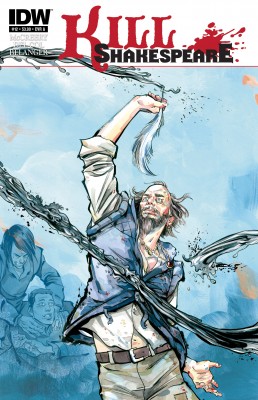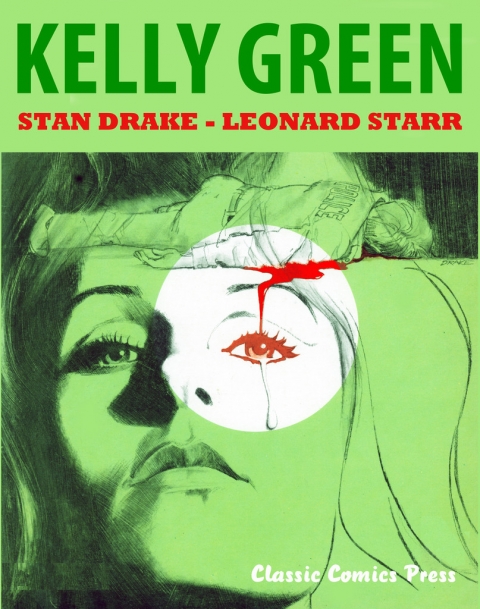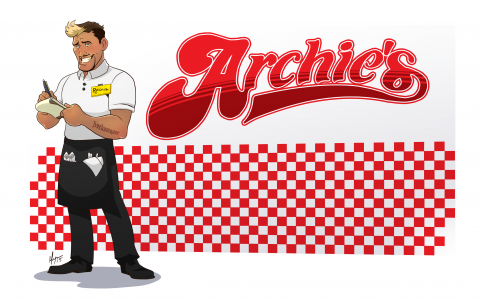Writers: Anthony Del Col and Conor McCreery
Artist: Andy Belanger
Colours: Ian Herring
Covers: Kagan McLeod (A), Andy Belanger (B)
Letters: Chris Mowry
Publisher: IDW Publishing
Last week the final issue of the critically acclaimed series Kill Shakespeare hit comic book stands. Let’s take a look at the final issue of the series and see what fate befell Shakespeare and his characters.
The Road So Far…
What happens when Shakespeare’s greatest creations come together? An epic war between good and evil, that’s what. But with the enigmatic creator of existence revealed and active in the fray, what will his final fate be as the forces of King Richard battle the Prodigals in a final showdown.
What’s the Story?
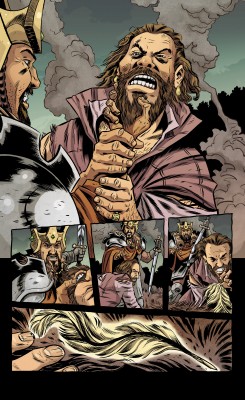
Richard takes Shakespeare by the throat and casts him down to the ground, the world’s creator now face-to-face with his quill; his greatest instrument resting on the ground in front of his face. With it in his grasp, Shakespeare attacks Richard and stuns him, using the opportunity to attack the king further to maintain his advantage. With Richard all but defeated, Shakespeare urges Richard to yield, a proposition the king quickly dismisses. Elsewhere on the battlefield, Iago and Hamlet continue their fight until Hamlet successfully throws Iago from his back and punches him. Hamlet questions Iago’s sudden turn, noting the true, sincere bond between he and Othello. After a moment’s contemplation, Othello arrives and quickly beheads his dear friend. Othello and Hamlet leave Iago’s resting place and quickly rejoin the battle to find Shakespeare and Richard still duelling to the death over Will’s magical quill. Richard finally obtains the upper hand and claims the quill as his own, gaining the attention of Lady Macbeth who had been fighting with Juliet elsewhere. She appears behind the king and blasts him with her sorcery, while Romeo regains consciousness much to the delight of his star-crossed love. Hamlet arrives on the scene just as Richard and Lady Macbeth begin to fight over the quill. Amid the chaos, Shakespeare regains his weapon and uses it to slay Richard. Despite requesting the Lady to yield, Lady Macbeth refuses and disappears. With Lady Macbeth gone and Richard dead, Shakespeare appears above the battlefield and demands that all forfeit their weapons and end the conflict. That night, the Prodigals have a party to celebrate their victory, which Shakespeare decides not to attend. Instead he leaves the town behind to go out into the world and reconnect with the people he created, leaving Hamlet to deliver a final message to the Prodigals. The series ends on a positive note, yet high in the sky, Lady Macbeth keeps a close, ominously scornful eye on the cheerful creations of William Shakespeare.
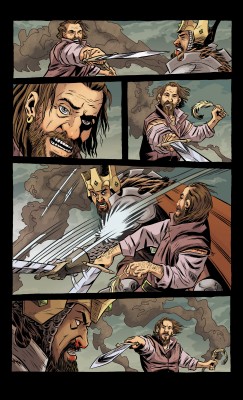
The writing in the issue creates a clear dichotomy in the demeanour of the principal characters within the issue, Richard III and Shakespeare. Richard, consumed by the rage of his own creation, attacks Shakespeare and finally obtains the infamous quill belonging to the playwright. Richard comes across as a vengeful and fury-filled antagonist in this issue, his raison d’etre materializing with greater clarity as his arc reaches its end. Richard’s arc has evolved from simply being an “evil” villain to that of a son striking back against his own father, as though he were quarreling with his abandonment issues. Ultimately the relationship between “father” and “son” is much less about the object itself—the quill—and is founded more upon Richard’s own disdain for his existence, combined with wishes to claim what he believes, in a sense, is his birthright. As with Shakespeare’s plays, tragedy strikes and Richard is killed not long after the climax of his arc. There’s a sense of poetry in the writing of the issue, all the more prevalent in the death of Iago at the hands of Othello. Iago’s arc has been a roller coaster of deception, leaving readers to wonder the extent of his wickedness and how much of his character is truly of that disposition. The answer is given beautifully, and despite his wickedness, we ultimately find his comradery with Othello was true as he fails to find the words to discredit Hamlet’s questioning of whether Lady Macbeth could love Iago more than his friend, his death coming moments later. Finally, Hamlet completes his arc, guiding Shakespeare and effectively saving him from himself. Hamlet has acted primarily as a foil to Shakespeare’s character and guided him much in a way that mirrors the Hamlet-Falstaff dynamic that was central throughout much of the series. The “Shadow King” becomes a chief confidant in a sense, pushing the “god” of this universe beyond his failings towards his purpose, thereby completing their stories simultaneously. The final issue of the series also brings Hamlet a happy ending, despite Juliet exerting her hard-nosed personality outward onto Hamlet for trying to push she and Romeo together again. The two run out to dance in the town square from the shadows, but not before Juliet places a swift knee into his nether-regions. Despite their glee, the issue ultimately ends on a note of realism, as Lady Macbeth’s cold, green eyes indicate although the battle is over, the war is not won.
The Pretty, Pretty Pictures
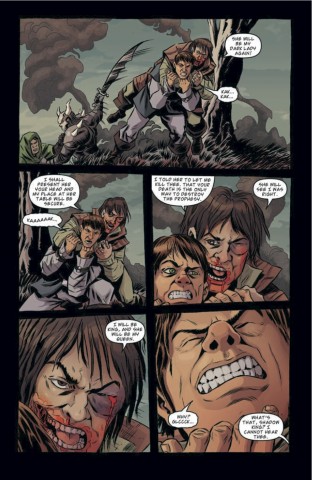
The words, “best,” “work” and “series” very clearly sums up the work put forth by Belanger in the final installment of Kill Shakespeare. Despite his tremendous efforts across the first 11 issues, Belanger outdid himself providing some of the most inspired, gruesome and creative work of the series. The pages chronicling Iago’s death were remarkably drawn. Continuing the sequence from the previous issue, we find Iago on Hamlet’s back as he clasps on a choke-hold in his attempt to bring Hamlet down. Hamlet turns the tide in a series of panels where he forces Iago to release him, in a swift move flooring him with a strong left-hook, and then in his final moments as Hamlet asks him whether Lady Macbeth could ever love him more than Othello, Belanger dramatically wipes Iago’s sinister grin from him face. As he contemplates and stumbles over Hamlet’s question, a silhouette slowly appears from the bottom corner of the panel, followed by a bloody “shhkkk.” Belanger’s talents shine once more in the next two pages as Hamlet silently watches Iago’s body crumple to the ground in a series of five panels. The lack of dialogue on the page allows for Belanger’s work to speak for itself, as Hamlet’s shock and horror are catalogued almost frame-by-frame, ending with a silent half-page depiction of Othello callously posed after striking down his friend, bloody sword in hand. The page reminds me of a scene from Serenity, a film written and directed by Joss Whedon based off of his cancelled television series, Firefly. In the film one of the characters abruptly dies, while their companion with whom they were emotionally attached is forced to soldier on despite their feelings about the situation. I sense a similar element here: Belanger’s work is contrasted by Del Col and McCreery’s dialogue which paints a different picture altogether. The reality is though, that the dialogue has significantly less impact on the reader if not for the posed depiction of Othello holding his sword. The two combine to create a very real truth—Othello killed Iago with a heavy heart. The page concludes with Hamlet and Othello walking away, while Iago’s decapitated head rests on the ground, his face battered to create a two-face effect à la Harvey Dent, which nicely sums the torment and polarization of his character.
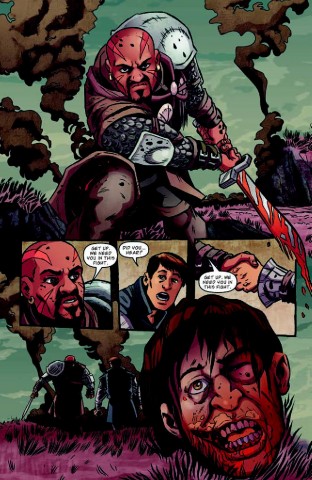
Throughout the issue Belanger in several instances captures several frames of motion on a single panel, such as an early page where Richard swings his sword at Shakespeare, once Richard picks up the quill and Richard’s death sequence which follows his initial injury; he stumbles and falls to his knees, ending with him face down on the ground. They’re very interesting, cool ways to draw sequences of events all on a single panel. They look great on the page and are very creative ways to tell the story visually. Elsewhere, in an earlier panel during the Shakespeare-Richard conflict, Richard gains the upper-hand by kicking a kneeling Shakespeare to the ground. This is followed by a scene depicted horizontally with Richard in the background as he kicks Shakespeare in the mid-section, his sword raised in preparation for a strike. The panel that follows is a natural continuation of the event with Shakespeare face down, while Richard is depicted at two stages of motion as he strikes Shakespeare across the face. It’s not all doom and violence, as Belanger ends the issue with a sense of comedy as Juliet takes clear exception to Hamlet pushing her and Romeo together. Belanger drew her unassumingly as she strolls up to Hamlet during the Prodigals’ celebration. Without hesitation she thrusts her knee into Hamlet’s groin, leaving her love in tears, before inviting him to dance once he recovers. The series’ final page ends with all in celebration under Lady Macbeth’s ever sinister, watchful eye. The final page reveals curtains alongside the side of the page, bringing the series to a close.
Final Thoughts
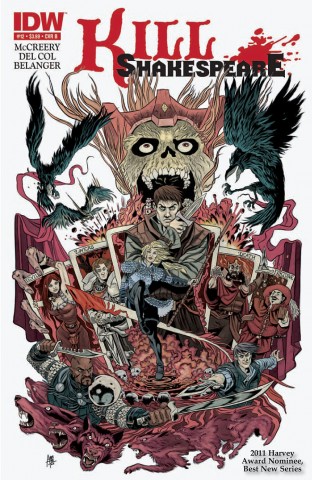
Issue 12 of the series didn’t disappoint. The final installment of Kill Shakespeare brought all of the story lines to a natural, organic conclusion without seeming forced or contrived. I found myself satisfied with the resolutions to the storylines revolving around Hamlet-Juliet, Hamlet-Shakespeare, Richard-Shakespeare, and Iago-Othello. The Hamlet-Juliet story blossomed naturally over the latter half of the series, bringing them together at a point where Hamlet’s character is confident and evolved enough where it’s comparable to the unwavering strength of Juliet’s personality in the series. I thought, although they’re caring and loving of each other, that the moment at the end was a nice cap to their journey towards one another. I feel like they came away with a mutual respect for the other, which their romance can easily build on going forward in future stories.
The Richard-Shakespeare dynamic was also interesting. I felt like by the first few pages of the final issue that Richard almost hated Shakespeare not necessarily just from the perspective of squandering his godhood, but in the role of failing him as a father for creating him as he did and not guiding him. I sense a genuine disdain for Shakespeare, sensing more of a father-son dynamic than in any other relationship in the series. Iago and Othello was an interesting story in that Iago truly believed himself wicked, similarly to Richard, but in his final moments has an epiphany. He comes to understand that despite their disagreements, Othello truly loves Iago, while he always searched for his approval in a sense, a theme explored in an earlier issue. Iago’s was a poetic end, dying at the moment he realizes where his true allegiance should have been. Finally, Hamlet and Shakespeare’s story arc is uniquely entwined, closely resembling the relationship between Hamlet and Falstaff. He aids Shakespeare similarly as a confidant, later functioning as an appropriate foil to Shakespeare in order to humanize him and encourage him to introduce himself back into society and reconnect with his creations. Despite the bulk of the greater story centering on Hamlet, it’s almost as though the story becomes about Shakespeare by the end. As the story closes, we find Hamlet and Shakespeare mirroring each other in the completion of their individual arcs; Hamlet accepts his role and the love of Juliet, while Shakespeare re-enters society and looks to reconnect with his people in order to understand each of them better. Although their paths are divergent, their journeys are identical. There’s something very humanized in Shakespeare’s story, as despite his effectively being a god, he chooses to walk among the people in contrast to standing above them as Richard would have.
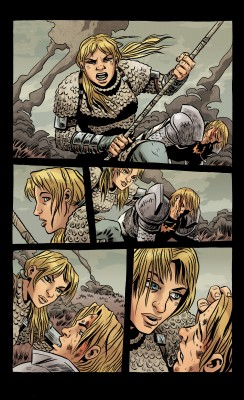
The twelfth issue of the series capped off a fantastic story that hit every point, offering strong, engaging storytelling combined with fantastic, creative artwork that never let-up over its 12 issue run. The final issue, or act, of Kill Shakespeare offers a satisfying conclusion to the plot, while also leaving the potential for a follow-up story to develop naturally from the series’ final acts. Del Col, McCreery and Belanger’s work on the series was a perfect marriage of talents complementing each other, resulting in the creation of one of the most engaging reads on comic book stands over the last year. Conceptually the book is brilliant, and it was executed in such a way that the classic depictions of the characters are paid homage to, while allowing them to grow and breathe on their own. Kill Shakespeare hit its marks and offered a tremendously engaging, fun reading experience that is as heart warming as it is gut wrenching, and as worthy of its critical praise as any of the greater works in comic book history.

